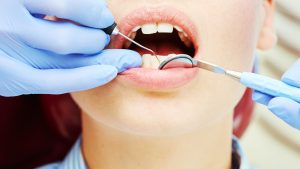
Are you familiar with the term “calculus bridge”? Despite its mathematical-sounding name, it’s actually a dental issue that can have significant consequences on your oral health. In this blog post, we will delve into the world of calculus bridge, exploring its causes, side effects, risks, treatment options, and prevention strategies. By the end, you’ll have a comprehensive understanding of this dental problem and how to keep your smile healthy and bright.
Key Takeaways
- Calculus bridge is a hardened mineral deposit on teeth that can cause oral health issues if left untreated.
- Early detection of calculus bridge is important and preventive measures include proper hygiene, hydration, and regular dental visits.
- Treatment options for managing calculus bridge may involve professional deep cleaning or removal. Prevention includes good oral hygiene practices with the help of a dental professional.
Understanding Calculus Bridge
 Calculus bridge, also known as dental calculus, is a hardened mineral deposit on teeth caused by plaque buildup. When calculus forms and coats multiple teeth in a row, it subsequently fills in the intervening spaces, leading to the formation of a calculus bridge.
Calculus bridge, also known as dental calculus, is a hardened mineral deposit on teeth caused by plaque buildup. When calculus forms and coats multiple teeth in a row, it subsequently fills in the intervening spaces, leading to the formation of a calculus bridge.
This dental issue, known as periodontal disease, can lead to a variety of oral health problems if left untreated, such as gum disease, tooth decay, and even tooth loss.
Dental Plaque vs. Calculus Bridge
Differentiating calculus bridge from dental plaque is the first step towards understanding what it is. Dental plaque is a soft, adhesive film composed of bacteria, leftover food particles, and saliva. It can harden and develop into tartar if not removed through proper dental hygiene.
On the other hand, calculus bridge is a compact, solid deposit linking adjacent teeth along the gumline. Understanding this distinction matters since dental plaque can be easily removed and prevented, in contrast to the often professional intervention required for calculus bridge.
When plaque is not removed, it can harden into calculus or tartar, which adheres firmly to tooth surfaces. This hardened form of plaque is more difficult to remove than its soft counterpart, as it requires specialized dental tools and procedures. As calculus accumulates on teeth, it can contribute to:
- gum infections
- tooth decay
- bad breath
- gum recession
- tooth loss
Regular dental cleanings and good oral hygiene practices can help prevent the buildup of calculus and maintain optimal dental health.
Factors Contributing to Calculus Bridge Formation
There are several factors that contribute to the formation of calculus bridges. Inadequate oral hygiene can result in the accumulation of plaque and bacteria, which can lead to calculus bridge formation. Dry mouth or xerostomia can also contribute to this issue, as it leads to a decrease in salivary production, resulting in an increase in bacteria and plaque accumulation.
Moreover, infrequent dental appointments can exacerbate the problem, as the presence of plaque and bacteria increases when dental visits are not done regularly. Addressing these factors aids in minimizing the risk of developing calculus bridge and maintaining good oral health. Keeping a diligent oral hygiene routine, staying hydrated, and making regular dental visits are essential steps in preventing this dental issue.
Recognizing the Signs of a Calculus Bridge
Timely treatment and prevention of further oral health issues hinge on early detection of calculus bridge. Signs of a calculus bridge may include a brown or tan border along the edge of the teeth adjacent to the gumline and difficulty in flossing between teeth due to the solid deposits. These deposits create a hard, solid barrier that is challenging to remove, making it difficult to brush your teeth and floss between them effectively.
Additional indications of calculus bridge include:
- Halitosis
- Red and swollen gums accompanied by bleeding (which may lead to gum infections)
- Discoloration of tartar to a black hue
- A whitish-yellowish deposit along the gum line and across several teeth.
Consulting a dental professional for an assessment and appropriate treatment becomes necessary if you notice any of these signs.
Potential Side Effects and Risks

Leaving a calculus bridge untreated can lead to various side effects and risks, which can be detrimental to your oral health. Halitosis, or bad breath, is a common side effect resulting from the buildup of bacteria in the mouth. Gingivitis, a form of gum disease characterized by red or inflamed gums and bleeding when brushing or flossing, is another potential consequence of untreated calculus bridge.
Receding gums, cavities, and tooth loss are additional risks associated with an untreated calculus bridge. The accumulation of tartar on teeth can provide a protective barrier for bacteria, leading to the formation of small openings in the enamel. This allows bacteria and acid to penetrate the tooth, causing tooth decay and potential tooth loss.
Addressing calculus formation promptly is key to preventing the side effects and risks associated with calculus bridge formation.
Treatment Options for Calculus Bridge
If you are diagnosed with a calculus bridge, treatment options include professional deep cleaning and root planing, performed by a licensed dental hygienist or dentist. During a professional teeth cleaning, your dental professional will use specialized tools, such as a dental scaler or ultrasonic instruments, to remove the calculus deposits from your teeth.
Another viable treatment option for maintaining proper dental hygiene is calculus bridge removal. The process involves root planing, which includes leveling the surfaces of the roots. Together, these procedures can effectively remove calculus bridge and restore the patient’s oral health.If you’re dealing with a caclus bridge, treatment options such as professional deep cleaning and root planing are essential for restoring oral health.
Prevention Strategies for Calculus Bridge

Maintaining good oral health is contingent on preventing calculus bridge formation. To prevent calculus bridge, practice good oral hygiene by brushing your teeth at least twice a day, using a fluoride toothpaste, and avoiding sugary and acidic foods that can contribute to calculus deposits.
Another vital prevention strategy is regular dental check-ups. During these check-ups, your dentist, who follows the American Dental Association guidelines, will assess your teeth and gums for signs of calculus bridge and other dental issues, and provide professional cleaning to remove plaque and calculus buildup.
Additionally, using toothpaste containing pyrophosphates or zinc citrate can aid in the prevention of calculus bridge by eliminating plaque and hindering its accumulation.
The Role of Dental Professionals

The role of dental professionals is instrumental in identifying, treating, and preventing the formation of calculus bridge. Their expertise enables them to accurately diagnose the condition and suggest the most suitable course of action. Dental professionals can provide treatment options such as scaling and root planing to aid in the removal of calculus bridge and the restoration of the patient’s oral health.
Moreover, dental professionals can offer counsel and direction on how to forestall calculus bridge, including correct oral hygiene and regular dental visits. Adhering to the guidance of dental professionals ensures sustained optimal oral health and prevention of calculus bridge and other dental issues.
Summary
In conclusion, calculus bridge is a dental issue that can have significant consequences on your oral health if left untreated. By understanding its causes, recognizing the signs, and seeking professional treatment, you can prevent and address calculus bridge formation. Additionally, maintaining proper oral hygiene, making regular dental visits, and following the guidance of dental professionals can help you sustain optimal oral health and prevent future dental problems.
Frequently Asked Questions
What is a calculus bridge?
A calculus bridge is a hardened, plaque-based substance that forms across multiple teeth and causes gum disease, tooth decay, and chronic bad breath.
How do you remove a plaque bridge?
To remove a plaque bridge, daily flossing, antiseptic mouthwash, baking soda brushing and vinegar gargling are recommended. Professional cleaning may also be necessary, involving the use of hand instruments or ultrasonic instruments to scrape and break down calculus buildup before it can be removed. Root planing may also be necessary for smoothing out root surfaces.
Which toothpaste is best for calculus?
For the best results in calculus removal, TartarEnd® toothpaste is the most recommended option as it has been patented and proven to dissolve, soften, and remove plaque and dental calculus.
What is the difference between dental plaque and calculus bridge?
Dental plaque is an adhesive, soft film composed of bacteria, saliva, and food particles, while calculus bridge is a hard, solid deposit connecting teeth at the gumline.
What are the potential side effects and risks of leaving a calculus bridge untreated?
Leaving a calculus bridge untreated can lead to unpleasant halitosis, painful gingivitis, receding gums, cavities and even tooth loss.



